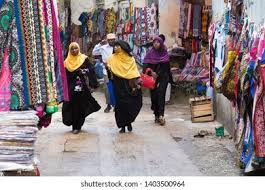By: Jemimah Chungu
The Swahili culture alongside Swahili fashion is one of the richest cultures across the globe. The Swahili fashion is one of the most unchanged fashions. This fashion can be described as a ‘positively rigid’ fashion from the clothes to the accessories and arts. The Swahili people are a group of Swahili language speaking people from natively from; Tanzania, Kenya, Uganda, Mozambique, Congo and Malawi.
It is noted that the Swahili fashion was influenced and has been infused with Arabian and Persian culture and fashion as well as religions like Christianity and Islam. Yet the Swahili ethnic fashion was originally much of what it still is fashioned today. They garbed clothing expressing their culture and art in their own conception in fabrics and fashion such as the kanga, Kitenge, maxi dresses and headwear and they still hold on to their original cultured fashion and accessories no matter how influential their religions or mixed ethnicities.
The fashion infusion was elaborated as adopting to new generational, gender, status and ethnic identities and Swahili young city dwellers – both men and women, Christians and Muslims, elite and non-elite – creatively ‘appropriated’ Western clothes in order to express new identities and aspirations, foster social changes, and sometimes bring about political transformations.
However, educated Africans used letters to the editor and mashairi (poems) – as a forum mainly to make comments and complain about ‘new’ clothing styles (JSTOR). Nevertheless, presently, since most Swahili people accepted Islam, their Muslim heritage, compels them not to create fashion designs with living beings like animal skin and insects (like the insect couture), they instead design geometrically.
The Kanga is their regular African print cloth that is also an artifact of Swahili culture. It is made with extreme care and creativity of the highest form. Like everything in fashion, the Swahili pay great attention to detail when it comes to their Kanga. Though this Afrocentric fabric is quite cheap, it is of great importance to the Swahili people. The Kanga is made in Tanzania and exported to other eastern and southern countries and it is quite popular among the women (Fab Ol’style).
Kitenge is another Swahili important fashion fabric of African print. It highly resembles kanga but is made from wax fabric and considered quite prestigious. There are other Swahili fabrics and it is significant to note that these fabrics are used to make the “rigid” fashion in Swahili nations such as trendy maxi dresses that still collaborate with Islam.
Beads are also an untouched fashion trend of Swahili fashion. Beads are designed and accessorized as head wear, anklets, necklaces, waist beads, bracelets and others.
Swahili fashion fabrics and accessories are one of the most used fabrics in the trendy Afrocentric fashion industry. They are suitable for stylish clothing, footwear and accessories and they taste all genders, age groups, religions, and social hierarchy. An evident example is runways such as Swahili fashion week held in Tanzania


